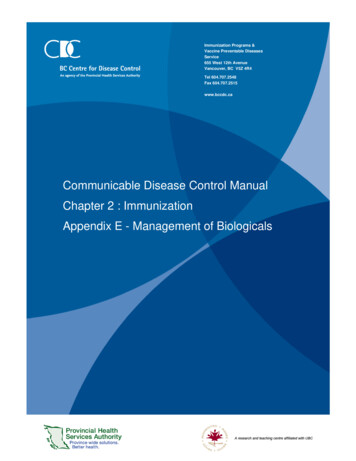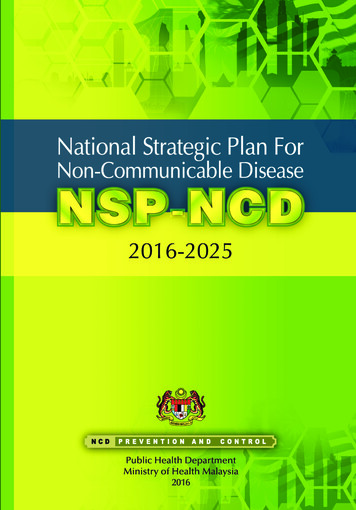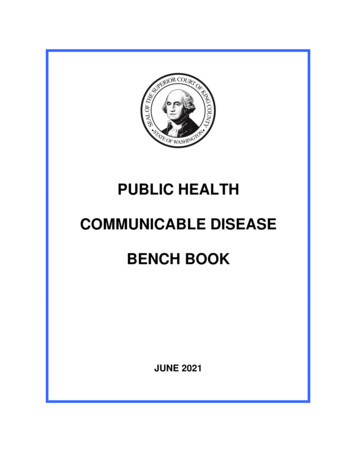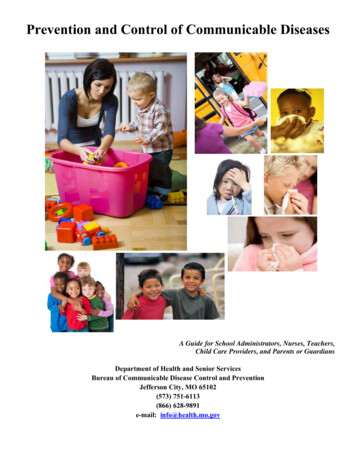
Transcription
Immunization Programs &Vaccine Preventable DiseasesService655 West 12th AvenueVancouver, BC V5Z 4R4Tel 604.707.2548Fax 604.707.2515www.bccdc.caCommunicable Disease Control ManualChapter 2 : ImmunizationAppendix E - Management of Biologicals
1.Table of ContentsThe Cold Chain .22.General Recommendations .23.Equipment .34.5.3.1Refrigerators . 33.2Backup Power Supply . 53.3Temperature Monitoring . 53.4Insulated Containers. 73.5Ice Packs/Gel Packs. 73.6Insulating Materials. 7Handling Biological Products .74.1Vaccine Delivery to Health Units . 74.2Vaccine Storage . 94.3Vaccine Orders . 104.4Principles of Vaccine Handling . 114.5Transportation and Management of Vaccines for Clinics . 114.6Mass Immunization Clinics . 134.7Returning Biological Products. 13Management of a Cold Chain Incident .145.1Power Failure . 165.2Equipment Malfunction . 165.3Algorithm 1: Cold Chain Incident within Health Authority . 175.4Algorithm 2: Cold Chain Incident from BCCDC to Health Authority . 186.Vaccine Stability Chart Information .197.Forms .198.Resources .209.References .20Communicable Disease Control ManualChapter 2: ImmunizationAppendix E - Management of BiologicalsOctober 20151
1. The Cold Chain“Cold chain” refers to the process used to maintain optimal temperature conditions during the transport,storage, and handling of vaccines, starting at the manufacturer and ending with the administration of thevaccine to the client.Vaccines are sensitive biological products; protection of vaccine potency and stability is important. Therecommended temperature for vaccine storage and handling is, at all times, between 2 C to 8 C.Biologicals may be inactivated by exposure to excess light or heat or freezing, depending on the nature ofthe product, the temperature reached and the duration of exposure. Any loss of vaccine potency ispermanent and irreversible. Damage from successive exposures to adverse conditions iscumulative. It is important to know the correct storage conditions for each biological product and to ensurethat each is kept under the recommended conditions.As a general principle, 0 C to 2 C is considered “refrigeration conditions”, with due regard to the accuracyof the temperature reading device. Products exposed to a validated temperature in this range for anyperiod of time, even for a series of exposures are not considered to have undergone a cold chain incidentand do not need to be reported. The exception to this is Tubersol for which exposures to temperatures inthe 0 C to 2 C temperature range do constitute a cold chain incident and must be reported using the ColdChain Incident Form.It is extremely important to have a thermometer calibrated to an accuracy of /- 1 C or better. Place thethermometer probe centrally (in the middle of the middle shelf) in the refrigerator, where temperatures aremore constant and less likely to fluctuate.When the refrigerator temperature is in the 0 C to 2 C range, adjust the refrigerator temperature andrestore to the recommended (between 2 C to 8 C) range immediately. See Section 5. Management ofa Cold Chain Incident for more information.All biological products freeze at temperatures below 0 C; products that have been exposed totemperatures below 0 C may not be usable. Specific exceptions to this (e.g., lyophilized products) areprovided in the Vaccine Stability Chart.The Vaccine Stability Chart is a reference provided to Biological Products Consultants to guide product usewhen biologicals are exposed to temperatures outside the acceptable range. This chart contains updatedstability information from the vaccine product monographs and the manufacturers. No vaccine should beremoved from cold chain conditions nor returned to BCCDC until it has been determined that the productcannot be used.2. General RecommendationsTo facilitate cold chain management: Designate one person, at the Health Service Delivery Area (HSDA) level, as a Biological ProductsConsultant (BPC) to be responsible for decision-making regarding continued use of vaccinesfollowing cold chain incidents, based on known stability data. When the Vaccine Stability Chartdoes not contain sufficient information in order to make a determination about vaccine usage, theBPC will consult with BCCDC Vaccine and Pharmacy Services. The BPC will ensure that all staffwho handle vaccines are trained in biological management procedures. The BPC will reviewCommunicable Disease Control ManualChapter 2: ImmunizationAppendix E - Management of BiologicalsOctober 20152
documentation for vaccine storage and confirm that conditions comply with the criteria establishedby Vaccine and Pharmacy Services for vaccines that are to be returned to BCCDC forredistribution.Designate one person, at the Health Unit office level, as the Biological Products Monitor (BPM) tobe responsible for ordering, receiving and storing all biological products, auditing inventories, andtracking exposure history for every exposed product. The BPM is also responsible for twice-dailymonitoring of the refrigerator internal temperature, and arranging for service calls and maintenancefor the biological refrigerators. The BPM will maintain documentation at the office level to supportstorage conditions for vaccines that are returned to BCCDC for redistribution.Designate a backup for the BPC and the BPM.Designate an individual within the local office to review vaccine orders quarterly with the BPM. Thisindividual should be familiar with immunization schedules and the frequency of immunizationclinics, the birth cohort for the office, school programs and seasonal demands for vaccines. SeeSection 4.3 Vaccine Orders.Have written standard operating procedures for vaccine storage and handling available at each siteto facilitate cold chain management by all staff.Maintaining the quality of biological products is the shared task of manufacturers, vaccine handlers, and allhealth care professionals responsible for immunization delivery.All staff must be aware of: the importance of the cold chain and the implications of cold chain incidents standard vaccine storage and handling practices the immediate and appropriate action to be taken in the event of a vaccine exposure totemperatures outside the standard storage conditions3. EquipmentThe essential cold chain equipment needed to transport and store vaccines includes:1. Dedicated refrigerator(s) for storing biological products2. A freezer3. Temperature monitoring devices4. Insulated containers (coolers)5. Ice packs (frozen)6. Gel packs (stored at biological refrigerator temperatures)7. Insulating material3.1 Refrigerators See National Guidelines, Section 3, for detailed information on refrigerators.Store biological products preferably in a purpose-built refrigerator, (also called a pharmacy,vaccine, biologicals, laboratory or industrial grade refrigerator).Domestic frost free refrigerators can be used, however, temperatures may fluctuate in differentcompartments of the refrigerator, and vaccines can only be stored in certain areas. For details, seeNational Guidelines or eziz.org references above.Pharmacy grade under-the-counter units are acceptable for vaccine storage.Communicable Disease Control ManualChapter 2: ImmunizationAppendix E - Management of BiologicalsOctober 20153
Standard “bar” fridges (small volume combination fridge/freezer with one exterior door) are notadequate because they do not maintain even temperatures.Refrigerators are “Vaccine Use” only. Do not store items such as food and beverages in vaccinerefrigerators, to prevent unnecessary opening of the refrigerator.It is preferable to store laboratory specimens in a refrigerator other than a refrigerator dedicated tovaccine storage. If laboratory specimens must be stored in a vaccine refrigerator, these specimensshould be stored in a separate, clearly-marked container.Choose an appropriate refrigerator size:o Consider the amount of vaccine that your health unit will use in your monthly order period.o Choose a refrigerator that can hold vaccines in the middle and upper shelves withoutcrowding.o Consider seasonal fluctuations when more vaccine may be required, for example, duringinfluenza season and for school immunization programs.The room in which the refrigerator is placed should have a thermometer to measure the ambient(room) temperature, and a thermostat to adjust the room temperature if required. In the absence oftemperature monitoring, room temperature is assumed to be 24 C unless circumstances warrantconsideration of higher temperature, such as direct sunlight or an additional heat source.Lock the refrigerator, or place the refrigerator in a room that can be locked, to prevent unauthorizedaccess, product handling or refrigerator tampering.Close the refrigerator door tightly. Installing a Velcro latch can help ensure that the door isn’taccidentally left ajar during the day, or after hours.Maintain the refrigerator temperature between 2 C to 8 C. A temperature of 5 C provides asafety margin for temperature fluctuations.Place the refrigerator away from the wall or surrounding structures (according to manufacturer’srecommendations) to provide proper ventilation and air circulation on all sides.Ensure the area around (including behind and under) the refrigerator is clean and dust free. Thiswill help to ensure that the refrigerator is working at optimal levels.Protect the refrigerator from direct sunlight.Connect the refrigerator to a dedicated electrical circuit that is not used for other appliances.Use a plug guard on the electrical outlet for the refrigerator to prevent accidental disconnection frompower.Label the vaccine refrigerator’s power breaker switch in the electrical panel box: “VACCINEREFRIGERATOR – DO NOT DISCONNECT / DO NOT SWITCH OFF”.When refrigerators are newly installed or have been repaired, follow manufacturer’s instructions forestablishing the appropriate temperature. Test that the refrigerator is maintaining the appropriatetemperature before placing biologicals in the unit. When there are no manufacturer instructions,allow one week of twice daily refrigerator temperature monitoring before using the unit to storevaccines.Have a refrigerator maintenance check (cleaning coils, checking door seals) done regularly (atminimum, annually). See National Guidelines for a “maintenance” checklist.Documentation of maintenance will be critical when an equipment malfunction occurs. Keeprecords of all maintenance and service repairs for the lifetime of the refrigerator. Post therefrigerator maintenance and/or repair telephone number on the refrigerator for easy accessibility.Communicable Disease Control ManualChapter 2: ImmunizationAppendix E - Management of BiologicalsOctober 20154
3.2 Backup Power SupplyIt is best practice to have all refrigerators storing vaccines connected to a backup power supply, whichcomes on automatically in the event of a power outage. As of March 31, 2013, all refrigerators storing morethan 10,000 of BCCDC-supplied biological products should be connected to a backup power supply.A backup power supply may be a generator or battery-pack.Backup generators automatically provide power to the refrigerators to maintain the recommendedtemperature in the event of power outages. Backup generators should be tested as required by localbuilding and fire codes and should receive maintenance at least annually (check manufacturer’sspecifications for test procedures and maintenance schedules). Backup generators should have thecapacity to run continuously for 72 hours if necessary, and an adequate supply of fuel in place for this.Backup battery packs (uninterruptible power supply {UPS} units) are an alternative to generators.Considerations for use of UPS include the following: expected load (number and capacity {wattage}) of equipment backed up; amount of time that one chooses to provide backup power; features of the UPS (for example, some units come with electronic modules that adjust to variousconditions in the power supply); site features (such as space and weight-bearing capacity).Where a backup generator or backup battery packs cannot be installed, establish a written agreement withan alternate storage facility (e.g., local hospital) with a backup generator, where vaccines can beappropriately and securely stored and monitored.Have a written plan for “urgent procedures” when weather conditions, natural disasters or otheremergencies might affect vaccine storage conditions.3.3 Temperature Monitoring3.3.1 Temperature AlarmsDevelop a 3-year plan for purchase and implementation of continuous-monitored alarm systems for allrefrigerators storing BCCDC-supplied biological products. Prioritize the refrigerators to be monitored,considering the volume and costs of products stored in the units, and complete implementation by March31, 2014.A monitored alarm system can prevent substantial financial losses in the event of an equipmentmalfunction that occurs outside of regular working hours. Install a continuous-monitoring temperature alarmor notification system with 24 hour and 7 days a week monitoring for vaccine refrigerators. The systemshould sound an audible alarm and alert one or more external monitors at a specified phone or pagernumber. Provide a fan-out list of health unit office/health authority contacts to be used by the externalmonitor. The contact list should be reviewed quarterly and updated for accuracy. Develop a written protocolto facilitate determining the nature of the problem and the process to manage the incident, to be used bystaff responding to a call from the external monitor.Communicable Disease Control ManualChapter 2: ImmunizationAppendix E - Management of BiologicalsOctober 20155
An alarm is not necessary when there is a small quantity of vaccine in an office only for a clinic day, andvaccines are returned to a central depot when the office is unattended.3.3.2 Minimum-Maximum Temperature Monitoring Use a constant temperature-recording device or digital minimum/maximum thermometer (withprobe) to monitor both the current refrigerator temperature and the minimum/maximumtemperatures reached.Thermometers should be calibrated to be accurate within /- 1 C or better.Check equipment annually, or according to manufacturer’s specifications, to ensure thermometermeasurement is accurate, batteries are functioning, and cables/probes are undamaged. Maintainand change batteries as recommended by the manufacturer, keeping in mind warrantyrequirements.See the National Guidelines for detailed information on temperature monitoring devices.Place the thermometer probe centrally (in the middle of the middle shelf) in the refrigerator, not atthe back, front or at the door.Have extra thermometers (ideally minimum/maximum thermometers) available for use in coolersthat are being used to store vaccines for several hours (e.g., for use at an off-site mass clinic). It isnot necessary to use a thermometer in insulated coolers being used to transport vaccine for a shortduration (e.g., from the health unit to physician’s office) or in small coolers used at a clinic workstation.At the start and end of each work day, record the minimum and maximum temperatures reachedsince the last monitoring, on the Temperature Form (see Section 7. Forms). Record thetemperatures on the form even when there is a continuous temperature recording device in use, orwhen the refrigerator is connected to an alarmed temperature system. Also record the currentrefrigerator temperature, ambient (room) temperature, and refrigerator dial setting. Reset themin/max thermometer once you have recorded the temperatures.Retain completed forms (and the weekly recording wheel from the continuous data logger, if used)in order to have a history of temperature maintenance for refrigerated biological products. Retainrecords for a minimum of three years, or for a longer period of time as determined by HA.3.3.3 TempTale Many biologicals orders shipped from BCCDC to the field will contain an electronic monitoring devicecalled a TempTale . This device will indicate a cold chain incident if the temperature during delivery isbelow 0.5 C or above 8 C. The TempTale provides time and temperature data for vaccine shipmentsfrom BCCDC to the field. Instructions for handling a TempTale are included in Section 4.1 VaccineDelivery to Health Units below.Temperature indicator cards and freeze tags are no longer used by BCCDC pharmacy.Refer to Section 5. Management of a Cold Chain Incident for management of vaccine exposures totemperatures outside of the appropriate range. No vaccine should be removed from cold chain conditionsnor returned to BCCDC until it has been determined that the product should not be used. Do not return anyvaccine unless directed to do so by your Biologicals Product Consultant or BCCDC Vaccine and PharmacyServices.Communicable Disease Control ManualChapter 2: ImmunizationAppendix E - Management of BiologicalsOctober 20156
3.4 Insulated Containers Insulated containers (coolers) are used to transport quantities of vaccine off-site during one workingday, or to store quantities of vaccine needed for immunization onsite during a working day, thusavoiding frequent opening of the refrigerator.The cooler must be able to maintain vaccine temperature between 2 C to 8 C during transportand throughout clinics.The temperature inside the cooler is maintained with ice/gel packs, and insulating materials.The cooler should meet the following criteria:o large enough to store vaccines, ice/gel packs, and insulating materials during transport;o external surface material is strong and durable;o lid is tight fitting.3.5 Ice Packs/Gel Packs Keep enough frozen ice packs and/or refrigerated gel packs (at 2 C to 8 C) ready to meet thevaccine transport needs of your clinic or health unit.Set ice packs on their edge and allow space between them for air circulation in the freezer.Stacking ice packs on top of each other in the freezer may result in uneven or partial freezing, anddecrease the efficacy of the ice packs.Ensure that ice packs are completely frozen before use.3.6 Insulating Materials Insulating materials are used as a barrier to prevent direct contact between vaccines and frozen icepacks.Insulating materials include flexible insulating blankets and gel packs at refrigerator temperature,bubble wrap, crumpled packing paper or Styrofoam peanuts.A layer of paper toweling is not sufficient as a barrier to protect vaccines from contact with frozenmaterial.4. Handling Biological Products4.1 Vaccine Delivery to Health UnitsVaccine shipments require immediate attention. Unpack and refrigerate biological products immediately upon their arrival. Vaccines that aredelivered by refrigerated truck are packed without any ice or gel packs; the temperature in thepacking boxes will rise dramatically unless the vaccines are refrigerated promptly.The National Guidelines provide a resource for tracking vaccine inventory. The Vaccine Tally Sheetmay be used to document arrival of a product, lot number and expiration date.Check for evidence of physical damage, freezing or excessive heat.Freezing affects the physical form of aluminum-adjuvanted adsorbed vaccines. It is thought thatfreezing causes the adsorbent to form larger, heavier granules that will gradually settle at theCommunicable Disease Control ManualChapter 2: ImmunizationAppendix E - Management of BiologicalsOctober 20157
bottom of the vial when the vial is shaken. The physical changes initiated by freezing provide thebasis for the shake test. A World Health Organization (WHO) Bulletin describing validation of theshake test to detect freeze damage is available at Validation of the shake test for detecting freezedamage to adsorbed vaccines. A “Shake test learning guide” is available in Annex 1 (pages 59-62)of a WHO document. The shake test is not necessary when the vaccine is frozen solid, or when ahomogenous solution cannot be obtained by vigorous shaking (white lumps/sediment cannot beseparated from the walls of the glass vials), as this is a sign that the vaccine has frozen.If you notice evidence of damage, label the products as “Do not use”, quarantine in the refrigerator,and contact your Biological Products Consultant for directions about vaccine use.In general, BCCDC will not accept vaccines from a manufacturer when a cold chain excursion hasoccurred, unless there is a significant reason to do so (e.g., the vaccine is in short supply and isdeemed unaffected by the exposure). BCCDC Vaccine and Pharmacy Services will provide thedetails of this initial exposure when these vaccines are shipped to the field.TempTale 4 USB (TT4USB) instructions:1. Remove the TT4USB device from shipping box immediately.2. Check the LCD window display: If a SUNSHINE symbol appears in the top left corner, this indicates that the device is stillrecording temperature. Proceed to STEP 3. If no SUNSHINE symbol appears, it is likely that the TT4USB was not started at BCCDC orstopped accidentally during transit. Quarantine the contents of the shipment immediately in therefrigerator and label “DO NOT USE”. Inform the BPC, but do NOT complete a Cold ChainIncident form. Contact the Biologicals Desk (604-707-2582) who will review the refrigeratedtruck record and provide direction regarding vaccine use. Proceed to STEP 6 to return theTT4USB to BCCDC Pharmacy.3. Firmly press and hold the red “STOP” button, located in the bottom right corner of the TT4USB forat least 3 seconds.A “STOP” icon will appear in the top right hand corner, indicating that the device has stoppedrecording the temperature. If no other symbol appears on the display window, this indicates the shipment has beenmaintained under cold chain conditions and is okay to use. Proceed to Step 4.If a BELL (alarm) symbol appears along with the “STOP” icon, this indicates the shipmentwas exposed to temperatures outside of the 0.5 C to 8 C range.Quarantine the contents of the shipment immediately in the refrigerator. They cannot be used untilfurther notice from BCCDC. Keep the contents segregated from other useable inventory while youawait a BCCDC response. If the shipment is urgent but has a bell you may choose to plug theTT4USB into a local PC USB port and save both files to your computer and then contact BCCDCPharmacy (604-707-2580). If more than one box needs to be quarantined, keep them separatedfrom each other as well. Proceed to Step 4.Communicable Disease Control ManualChapter 2: ImmunizationAppendix E - Management of BiologicalsOctober 20158
4. Press the green “Start” button to view and record the transit temperature history. Information willappear in the window.The numbers indicate:a) average temperatureb) high (Hi-) temperaturec) low (Lo-) temperatureRecord the information from (a) through (c) on the TT4USB form. Pressing the “Start” button againwill repeat the display of the readings. Complete the entire form.5. Fax the TT4USB form immediately to the Biologicals Desk at 604-707-2582.6. Return the TT4USB monitor(s) immediately to BCCDC in the provided prepaid bubble envelope.Enclose a copy of the completed TT4USB form.7. Once BCCDC receives the TT4USB the information is downloaded and a consult will be providedback to the health unit office as early as possible, if required. Record the information provided byBCCDC on the TT4USB form that has been retained at the originating office.If unsure of proper procedure for the TempTale device, store the shipment and the TempTale inthe refrigerator until Biological Products Monitor or designate is available.See Algorithm 2: Cold Chain Incident from BCCDC to Health Authority.4.2 Vaccine Storage See Section 8. Resources, How to store Vaccines in the Refrigerator, for diagram illustratingplacement of biological products in the refrigerator. Use vaccines that have experienced a cold chain incident and have been determined to be usableat the first opportunity. “First to expire, first out”: rotate vaccine stock according to expiry date (placing vaccine with theshortest expiry date at the front of the shelf, and longest expiry date at the back) so that vaccinecloser to the expiry date will be used first. The expiry date is the date by which a vaccine or diluent should be used. When the date is markedas a month and a year, the vaccine or diluent may be used up to and including the last day of themonth. Note: some component vaccines and diluents may be assembled into one package with alabeled expiry date on the outer carton. This date is the shorter of the two dates of either thecomponent vaccine or the diluent in the package. Check biological products inventory on the last working day of each month. Remove expiredproducts to prevent the administration of expired product to a client. Check the expiry date on multi-dose vials which have been opened. Note vial(s) that will need to beremoved when the post-puncture expiry date is before the end of the next month, and remove thevial(s) on that date. Multi-dose vials are dated when first opened, and should be used within 30days of first puncture unless the product monograph specifies a shorter time period for use (e.g.,some influenza vaccine in multi-dose presentation must be used within 7 days of first puncture). Return all expired products to BCCDC Vaccine and Pharmacy Services (see Section 7. Forms,Field Return Form). Do not discard expired products locally.Communicable Disease Control ManualChapter 2: ImmunizationAppendix E - Management of BiologicalsOctober 20159
Check for product(s) that will expire within three months and if use is unlikely within that time in thelocal office, determine if another office within the region could use the product. Redistribute withinthe Health Authority as needed to avoid wastage.Keep a separate tray or container in the refrigerator for products that have been partially used orpreviously taken from the refrigerator for a clinic (protect from light, if applicable). Use thesevaccines before opening new vials or packages.Group the same biological products together and space the products to allow air circulationbetween rows.Keep all vaccines in their original packaging unless circumstances warrant providing less than a fullpackage to a community provider to avoid wastage.Store vaccines only on the upper and middle shelves in the refrigerator.Do not use refrigerator door shelves and crispers for vaccine storage as these areas are moresusceptible to temperature fluctuations.Store sealed bottles of water in the refrigerator to provide cold mass that will help to maintaininternal temperatures and delay temperature changes in the event of a power or refrigerator failure.Store flexible insulating blankets or gel packs that will be used as insulating material during vaccinetransport in the refrigerator.Diluent for vaccines can be stored at room temperature to conserve refrigerator space, unless theproduct insert specifies refrigeration.Store epinephrine at room temperature (15 C to 30 C) and protect from heat, light and moisture.Do not store epinephrine in the refrigerator.Open the refrigerator door only when necessary, and close it as soon as possible.4.3 Vaccine Orders Review inventory on hand and order vaccines as per the shipping schedule provided by BCCDCVaccine and Pharmacy Services for your office. Weekly ordering is recommended for large healthunit offices, biweekly for medium-sized offices, and monthly for small and isolated offices.Establish a base order for all vaccines or minimum quantity to be kept on hand at all times,considering the following:o the size of the age cohort (i.e., the number of births in the
to facilitate cold chain management by all staff. Maintaining the quality of biological products is the shared task of manufacturers, vaccine handlers, and all health care professionals responsible for immunization delivery. All staff must be aware of: the importance of the cold chain and the implications of cold chain incidents











